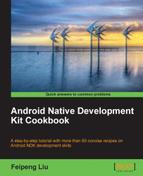This recipe discusses how to port a command-line executable to Android with an NDK build system. We will use the open source Fugenschnitzer program (fusch) as
an example.
You should read the Porting a library as a static library with an Android NDK build system recipe in Chapter 8, Porting and Using Existing Libraries with Android NDK, before going through this one.
The following steps describe how to port the fusch program to Android with an NDK build system:
- Create an Android application named PortingExecutable with native support. Set the package name as
cookbook.chapter9.portingexecutable. Refer to the Loading native libraries and registering native methods recipe in Chapter 2, Java Native Interface, if you want more detailed instructions. - Remove the existing content under the
jnifolder of the project. - Download the source code of the
fuschlibrary and command-line application from http://fugenschnitzer.sourceforge.net/main_en.html. Extract the archive files and put them into thejni/fuschandjni/fusch_libfolders respectively. - Download
libpng 1.2.50from http://sourceforge.net/projects/libpng/files/libpng12/1.2.50/ and extract the files to thejni/libpng-1.2.50folder. The latest version oflibpngwon't work because the interface is different. - Add an
Android.mkfile under thejni/libpng-1.2.50folder to buildlibpngas a static library module. The file has the following content:LOCAL_PATH := $(call my-dir) include $(CLEAR_VARS) LOCAL_CFLAGS := LOCAL_MODULE := libpng LOCAL_SRC_FILES := png.c pngerror.c pngget.c pngmem.c pngpread.c pngread.c pngrio.c pngrtran.c pngrutil.c pngset.c pngtrans.c pngwio.c pngwrite.c pngwtran.c pngwutil.c LOCAL_LDLIBS := -lz LOCAL_EXPORT_LDLIBS := -lz LOCAL_EXPORT_C_INCLUDES := $(LOCAL_PATH) include $(BUILD_STATIC_LIBRARY)
- Add an
Android.mkfile under thejni/fusch_libfolder to buildlibseamcarvas a static library module. The file content is as follows:LOCAL_PATH := $(call my-dir) include $(CLEAR_VARS) LOCAL_MODULE := libseamcarv LOCAL_SRC_FILES := sc_core.c sc_carve.c sc_color.c sc_shift.c sc_mgmnt.c seamcarv.c LOCAL_CFLAGS := -std=c99 LOCAL_EXPORT_C_INCLUDES := $(LOCAL_PATH) include $(BUILD_STATIC_LIBRARY)
- Add the third
Android.mkfile under thejni/fuschfolder to build thefuschexecutable, which uses the two static libraries built in the two folderslibpng-1.2.50andfusch_lib.LOCAL_PATH := $(call my-dir) include $(CLEAR_VARS) LOCAL_MODULE := fusch LOCAL_SRC_FILES := fusch.c LOCAL_CFLAGS := -std=c99 LOCAL_STATIC_LIBRARIES := libpng libseamcarv include $(BUILD_EXECUTABLE)
- Add the fourth
Android.mkfile under thejnifolder to include theAndroid.mkfiles under its subfolders.LOCAL_PATH := $(call my-dir) include $(call all-subdir-makefiles)
- Build the application and you will see a binary file,
fusch, under thelibs/armeabifolder. We can put this binary into a rooted Android device or an emulator with the following command:$ adb push fusch /data/data/
- Note that we will not be able to copy and execute the binary on a non-rooted Android device because we cannot get the permission to execute.
- Start the first command line on the console. We can grant the execution permission to the binary and execute it with the following command:
$ adb shell # cd /data/data # chmod 755 fusch # ./fusch
This will print out the help message of the program.
- Start the second command-line shell. Push the test PNG file
cookbook_ch9_test.png(available under theassetsfolder of the sample project's source code) to the testing device or emulator with the following command:$ adb push cookbook_ch9_test.png /data/data/
- Get back to the first command-line shell and execute the
fuschprogram again with the following command:# ./fusch cookbook_ch9_test.png 1.png h-200
- The program will take a while to resize the input image from 800 x 600 to 600 x 600. Once it is finished, we can get the processed image with the following command at the second command-line shell:
$ adb pull /data/data/1.png .
- The following screenshot shows the original image on the left and the processed image on the right:

The sample project demonstrates how to port the fusch program as a command-line executable to Android. We describe the sources to the Android
NDK build system in the Android.mk file and the NDK build system handles the rest.
The steps to port a command-line executable are as follows:
- Figure out the library dependencies. In our sample program,
fuschdepends onlibseamcarv(in thefusch_libfolder) andlibpng, andlibpngsubsequently depends onzlib. - If a library is not available on the Android system, port it as a static library module. This is the case for
libseamcarvandlibpngin our sample application. But aszlibis available on Android, we simply need to link to it. - Port the executable as a separate module and link it to the library modules.
We have covered most of the Android.mk variables and macros in Chapter 8, Porting and Using Existing Libraries with Android NDK. We will introduce two more predefined variables here. You can also refer to the Android NDK file docs/ANDROID-MK.html for information on more macros and variables.
LOCAL_CFLAGS: A module description variable. This allows us to specify additional compiler options or macro definitions for building C and C++ source files. Another variable that serves a similar purpose isLOCAL_CPPFLAGS, but for C++ source files only. In our sample project, we passed-std=c99to the compiler when buildinglibseamcarvandfusch. This asks the compiler to accept ISO C99 C language standard syntax. Failing to specify the flag will result in compilation errors at the time of building.BUILD_EXECUTABLE: A GNU make variable. It points to a build script that collects all information about the executable that we want to build and determines how to build it. It is similar toBUILD_SHARED_LIBRARYandBUILD_STATIC_LIBRARYexcept that it is for executables. It is used when buildingfuschin our sample project.include $(BUILD_EXECUTABLE)
With this explanation and the knowledge we acquired in Chapter 8, Porting and Using Existing Libraries with Android NDK, it is now fairly easy to understand the four Android.mk files used in our sample application. We ported libpng and libseamcarv as two static library modules. We
export the dependent libraries (with LOCAL_EXPORT_LDLIBS) and header files (with LOCAL_EXPORT_C_INCLUDES), so they are automatically included when using the module. When porting libpng, we also link to the zlib library (with LOCAL_LDLIBS) available on the Android system. Finally, we port the fusch program by referring to the two library modules (with LOCAL_STATIC_LIBRARIES).
